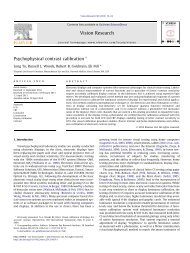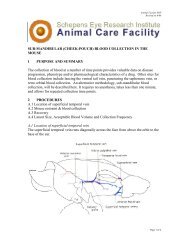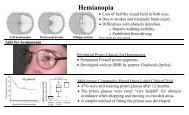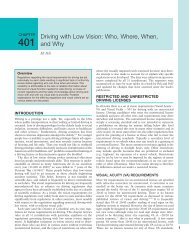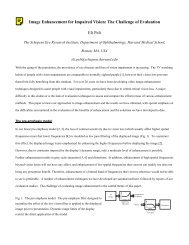In-the-Spectacle-Lens Telescopic Device for Low Vision
In-the-Spectacle-Lens Telescopic Device for Low Vision
In-the-Spectacle-Lens Telescopic Device for Low Vision
You also want an ePaper? Increase the reach of your titles
YUMPU automatically turns print PDFs into web optimized ePapers that Google loves.
A challenge to <strong>the</strong> beam-splitter based approach, however, is that any birefringence in <strong>the</strong>carrier lens material can rotate <strong>the</strong> polarization of <strong>the</strong> light. The rotated light will <strong>the</strong>n bepartially reflected, ra<strong>the</strong>r than transmitted, in <strong>the</strong> first pass through <strong>the</strong> second beam splitter andwill reduce <strong>the</strong> light efficiency of <strong>the</strong> system. Thus <strong>the</strong> carrier lens has to be as free as possiblefrom birefringence effects.To convert <strong>the</strong> astronomical Keplerian telescope design using beam splitters (Fig. 10) to aterrestrial setup requires an erecting system. Fig. 11 illustrates one such terrestrial designconstructed by rotating <strong>the</strong> two assemblies around axes perpendicular to <strong>the</strong> carrier lensultimately placing <strong>the</strong> spherical mirrors above <strong>the</strong> beam splitters. This design, similar to <strong>the</strong>basic Keplerian design (Fig. 4), uses <strong>the</strong> beam splitters as part of <strong>the</strong> image erecting system.Importantly, this design preserves <strong>the</strong> property that <strong>the</strong> width of <strong>the</strong> fields and <strong>the</strong> size of <strong>the</strong>objective are not limited by <strong>the</strong> thickness of <strong>the</strong> carrier lens.19




